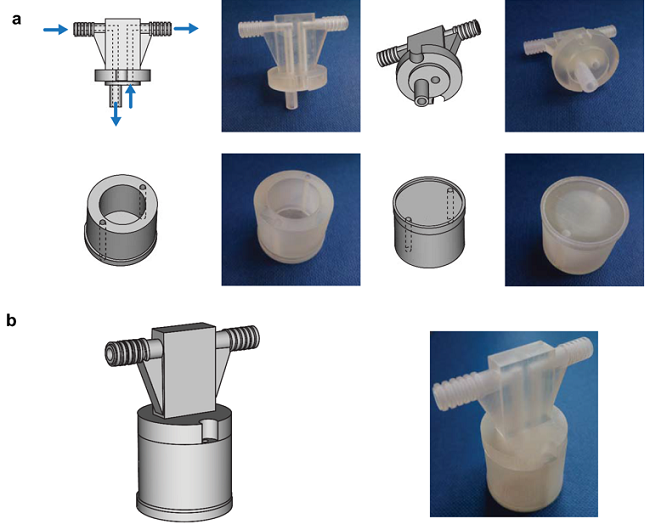Malaria is one of the world’s most severe public health problems, and a lot of work has gone into using 3D printing to help diagnose and even cure the disease.
 A group of researchers from Imperial College London is studying how malaria is transmitted, which requires mosquito test subjects to be infected with Plasmodium gametocytes – the blood stage parasites that actually cause malaria. In a Standard Membrane Feeding Assay (SMFA) test, an artificial membrane feeding apparatus, which simulates the host’s skin and body temperature, is used to get the mosquitoes to eat reconstituted blood containing the gametocytes. These feeders warm infected blood using glass chambers or electric heating elements, both of which are hard to acquire and expensive to boot.
A group of researchers from Imperial College London is studying how malaria is transmitted, which requires mosquito test subjects to be infected with Plasmodium gametocytes – the blood stage parasites that actually cause malaria. In a Standard Membrane Feeding Assay (SMFA) test, an artificial membrane feeding apparatus, which simulates the host’s skin and body temperature, is used to get the mosquitoes to eat reconstituted blood containing the gametocytes. These feeders warm infected blood using glass chambers or electric heating elements, both of which are hard to acquire and expensive to boot.
The team recently published a paper, titled “An inexpensive open source 3D-printed membrane feeder for human malaria transmission studies,” that presents their creation and testing of an inexpensive, 3D printed membrane feeder.
“Presented here is a simple two-piece water-jacketed membrane feeder designed to hold a volume of 500 µl,” the paper reads. “Using the files presented here, the feeder can be 3D-printed directly and inexpensively by stereolithography by any equipped lab or commercial 3D-printing provider. Alternatively, by using a CAD package the size of the feeder can be up- or downscaled to hold more or less volume respectively.”

a) The membrane feeder was designed in two parts, a top chamber that connects to a circulating water bath and a bottom chamber holding a water reservoir and the RBC/gametocyte/serum sample on the underside. b) Both pieces are glued together into a single, watertight unit.
The researchers created the two-part membrane feeder design using the free, open source CAD modeling program Art of Illusion, then had Shapeways 3D print the parts out USP VI medical-grade “Fine Detail Plastic” acrylic resin (VisiJet M3 Crystal). Then, they conducted three independent SMFAs, using the Plasmodium falciparum laboratory strain NF54, in order to compare the performance of their 3D printed membrane feeder to that of a commercial glass feeder.
According to the study, “Exflagellation rates as well as oocyst counts indicate that there is no significant difference between the two, within the statistical power given by triplicate SMFAs used as standard by the research community.”
The researchers believe that by making the design files for their 3D printed membrane feeder open source, more laboratories will be able to perform these SMFAs, and can even customize the design if necessary.
“The 3D-printed feeder design enables researchers to inexpensively produce their own SMFA feeders as an alternative to expensive and fragile glass feeders that require specialist manufacturing,” the study concludes. “This new 3D-printed feeder can be used in a wide range of applications in addition to standard SMFAs, as it is not limited to the species used here. Application might include the assessment of vector competence for malaria, the epidemiological assessment of the infectious reservoir for malaria, clinical drug trials, and transmission-blocking studies.”
Co-authors of the paper include Kathrin Witmer, Ellie Sherrard-Smith, Ursula Straschil, Mark Tunnicliff, Jake Baum, and Michael Delves. The design files for the 3D printable membrane feeder can be found in the paper.
Discuss this story and other 3D printing topics at 3DPrintBoard.com or share your thoughts in the Facebook comments below.
Subscribe to Our Email Newsletter
Stay up-to-date on all the latest news from the 3D printing industry and receive information and offers from third party vendors.
You May Also Like
New Report: Semiconductor Industry to See $1.4B in 3D Printing Revenues by 2032
“The semiconductor sector has become the most strategically significant area of global industry.” Truer words are hard to come by when it comes to the modern world, and they are...
Will Photonic-Crystal Lasers Revolutionize 3D Printing?
Powder bed fusion (PBF) for metals and polymers predominantly utilizes lasers as the primary heat source. Some directed energy deposition (DED) technologies also employ lasers, while various vat polymerization methods...
3D Printing Unpeeled: Orbex Investment, IndoMIM and HP, Ultrasonic Waves
INDO-MIM has bought three HP Metal Jet S100 printers, operating two in India and one in Texas. This is a win for HP because the company has deep experience in...
3D Printing Webinar and Event Roundup: April 21, 2024
It’s another busy week of webinars and events, starting with Hannover Messe in Germany and continuing with Metalcasting Congress, Chinaplas, TechBlick’s Innovation Festival, and more. Stratasys continues its advanced training...

































